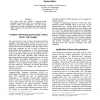Free Online Productivity Tools
i2Speak
i2Symbol
i2OCR
iTex2Img
iWeb2Print
iWeb2Shot
i2Type
iPdf2Split
iPdf2Merge
i2Bopomofo
i2Arabic
i2Style
i2Image
i2PDF
iLatex2Rtf
Sci2ools
FLAIRS
2006
2006
Computer-Aided Language Processing
The invited talk will introduce Computer-Aided Language Processing (CALP) as an emerging area of practical interest and significance and will present experiments of several CALP applications which show that while no quality is lost, much time is saved when employing CALP tools. Computer-aided language processing: context, history and examples The past years have seen a variety of promising Natural Language Processing (NLP) projects but in the vast majority of real-world applications, fully automatic NLP is still far from delivering reliable results the simple reason being that computers are not as good as humans at understanding human languages. In fact, pre-processing tools are far from perfect. By way of example, the best accuracy reported in robust parsing of unrestricted texts is around the 90% mark (Charniak 2000) whereas best performing anaphora resolution programs score only in the 60%s (Mitkov and Hallett, forthcoming). As a result, computer-aided methods have emerged as a pra...
Artificial Intelligence | Computer-aided Language Processing | Computer-aided Scenario | FLAIRS 2006 | Natural Language Processing |
| Added | 31 Oct 2010 |
| Updated | 31 Oct 2010 |
| Type | Conference |
| Year | 2006 |
| Where | FLAIRS |
| Authors | Ruslan Mitkov |
Comments (0)

